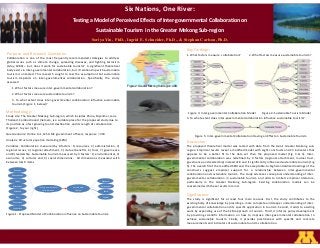
Six Nations, One River: Testings a Model of Perceived Effects of Inter-governmental Collaboration on Sustainable Tourism in the Greater Mekong Sub-region
- 1. Six Nations, One River: Testing a Model of Perceived Effects of Inter governmental Collaboration on Sustainable Tourism in the Greater Mekong Sub region Soriya Yin, PhD., Ingrid E. Schneider, Ph.D., & Stephan Carlson, Ph.D. Figure 2: Greater Mekong Sub-region, ADB. Purpose and Research Questions: Collaboration is one of the most frequently recommended strategies to address global issues such as climate change, spreading diseases, and fighting terrorism (Gray, 1989) –– but, does it work for sustainable tourism? A significant theoretical body exists in inter governmental collaboration, but it relationship with sustainable tourism is untested. This research sought to test the assumption that sustainable tourism depends on inter governmental collaboration. Specifically, the study assessed 1. What factors measure inter governmental collaboration? 2. What factors measure sustainable tourism? 3. To what extent does inter governmental collaboration influence sustainable tourism (Figure 1, below)? Methodology: Study site: The Greater Mekong Sub region, which includes China, Myanmar, Laos, Thailand, Cambodia and Vietnam, is a suitable place for the proposed study due to its position as a fast growing tourist destination and its length of collaboration (Figure 2, to your right) Questionnaire: Online to 1,125 GMS government officers; response = 359 Analysis: Structural equation modeling (SEM) Variables: Collaboration measured by 8 factors: 1) resources, 2) administration, 3) regional issues, 4) regional attachment, 5) mutual benefits, 6) trust, 7) governance and 8) leadership. Sustainable tourism measured by 4 factors: 1) environmental, 2) economic, 3) cultural and 4) social dimensions. All dimensions measured with between 4 & 9 items Figure 1: Proposed Model of Collaboration influence on Sustainable Tourism Inter governmental collaboration Administration Issues Resource Attachment Mutuality Trust Governance Leadership Sustainable Tourism Economic Cultural Environment Social Key Findings: 1. What factors measure collaboration? 2. What factors measure sustainable tourism? 3. To what extent does inter governmental collaboration influence sustainable tourism? .74 .55 Discussion: The proposed theoretical model was tested with data from the Asia’’s Greater Mekong sub region. Empirical results reveal a modified model with eight constructs and 23 indicators that appears to be a better fit to the data set than the proposed model (Fig 3 & 4). Inter governmental collaboration was redefined by 4 factors (regional attachment, mutual trust, governance and leadership) instead of 8 and it significantly influenced sustainable tourism (Fig 5). The overall fit of the modified SEM and the acceptable to high standardized loadings of the constructs suggest empirical support for a relationship between inter governmental collaboration and sustainable tourism. The study advances conceptual understanding of inter governmental collaboration in sustainable tourism and adds to limited empirical literature, particularly in the Greater Mekong Sub region. Existing collaboration models can be reexamined with these results in mind. Significance: The study is significant for at least four main reasons. First, the study contributes to the existing body of knowledge by providing a more complete and deeper understanding of inter governmental collaboration and its specific application in tourism. Second, it adds to existing work by expanding use of the SEM approach in tourism. Third, it informs policy development by providing scientific information on how to improve inter governmental collaboration to achieve sustainable tourism. Finally, it provides practitioners with specific and concrete measurements and indicators of sustainable tourism collaboration. .54 .73 .92 .82 .86 .87 .77 .57 .61 .74 .92 .55 .54 .28 .96 .74 .63 .73 .75 .53 .29 .53 .84 .67 .73 .75 .56 .33 .37 .55 .73 .84 .70 .63 .68 .83 .80 .49 .70 .88 .95 .84 .76 .92 .84 .80 .82 .91 .80 .67 .64 .33 .56 .82 .80 .57 .24 .49 .78 .90 .71 .58 Figure 3: Inter governmental Collaboration Model Figure 4: Sustainable Tourism Model Figure 5: Inter governmental Collaboration Having an Effect on Sustainable Tourism
